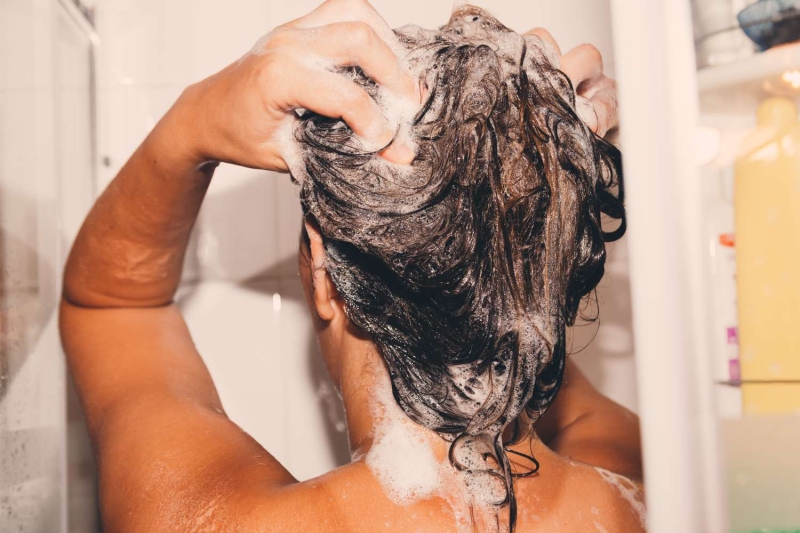Contents
First step: Try not to sweat it.
As soon as you begin to notice more hair on the shower walls and less on your head, your first instinct is probably to whip out your phone, fire up Google, and stressfully type in "how to get thicker hair" or "why is my hair falling out," only to be met with a scary list of medical articles. A lot of us have been there—80 million in America alone, to be exact. Consider this one of the not-scary articles.
Hair loss is stressful, yes, but it's also information. It's one of your body’s ways of telling you that something’s not quite right. Ahead are the most common reasons you might notice thinning hair, from genetics to your environment. And while it’s totally valid to freak out for a sec, remember that hair loss can give you the push you need to dive deeper with the help of a medical provider.
Meet the expert
- Heather Woolery-Lloyd, MD, FAAD is a board-certified dermatologist and founder of skin-care education site DermFriends. Helen Reavey is a board-certified trichologist and founder of hair and scalp-care brand Act+Acre. Jeannetta Walker-Rodgers is a celebrity hairstylist and the Joico global technical director.
Why Hair Gets Thinner
Genetics
You can thank mom for your perfect smile, and dad for your weird feet, but did they really have to pass down the hair-loss gene? Turns out, one of the most common sources of thinning hair is, in fact, androgenetic—or hereditary—alopecia. “Patients usually have a family history of thinning and notice thinning that extends to the frontal hairline,” says board-certified dermatologist Heather Woolery-Lloyd. “Widening of the part is one of the first things female patients notice.”
Stress
“A major stressful event like a car accident, hospitalization, sudden loss of a loved one, surgery, or childbirth can disrupt the hair growth cycle and lead to temporary shedding, also known as telogen effluvium,” says Dr. Woolery-Lloyd. (She notes that occasional stress is probably not the driver of hair loss.) However, if you get regular bloodwork and your cortisol levels prove to be consistently high, it could be worth implementing lifestyle changes to reduce your stress levels where possible.
Hormone Imbalances
“Hormonal changes, such as during menopause, perimenopause, or postpartum, can lead to hair thinning due to a reduction in estrogen levels,” says board-certified trichologist Helen Reavey. This can also happen with conditions like PCOS, which often result in higher levels of testosterone. When your hormones are out of balance, it might come with other symptoms too, like mood and skin changes. If you think something might be up, tell your primary care provider or dermatologist and they can help you get bloodwork done to get a read on your hormone levels.
Aging
While there are a number of things to look forward to as you get older (Wisdom! Smile lines! Retirement!), thinning hair is probably not one of them, but it is totally normal. “As we age, hair growth naturally slows down,” says Dr. Woolery-Lloyd. She says this can lead to finer, silkier hair and a decrease in overall hair density.
Medical Conditions
“Certain medical conditions, like thyroid conditions and autoimmune diseases such as alopecia areata and lupus can contribute to hair loss,” says Dr. Woolery-Lloyd. If you have these conditions, work with your specialist to devise a care plan. If you suspect you might have an underlying medical issue, schedule an appointment with your primary care provider who can refer you to a specialist.
Insufficient Nutrition
Deficiencies in protein and certain vitamins, minerals, and amino acids could play a role in hair loss, says Reavey. Raise your concerns to your doctor and they may order a full bloodwork panel to see your levels. Learning what you're deficient in before reaching for a supplement can save you tons of time and money.
Styling
Traction hair loss can occur if you wear your hair in slicked back styles, high ponies, and protective styles frequently. What’s more, Reavey says that excessive heat styling, coloring, and chemical processing can also make hair more fragile and fine over time.
Understanding Realistic Outcomes
Results depend on the cause of the hair loss. “Postpartum hair loss resolves within a year even without treatment, while hair loss from medical conditions can sometimes be more challenging,” says Dr. Woolery-Lloyd. She says that hair thinning from aging or hereditary hair loss can improve with things like topical or low dose oral minoxidil, but Reavey says it’s very challenging to reverse completely. Reavey notes that stress-related hair loss—and any form of telogen effluvium—typically are resolved on their own, but can be assisted with lifestyle interventions to soothe stress-related inflammation, such as meditation, good sleep, and regular exercise.
It’s key to understand that what works for someone’s hair may not work for yours. (Yes, even when the one thousandth influencer tells you colostrum gave them mermaid tresses.) That’s why the first step is figuring out the root of your hair thinning, so you can get a realistic view of potential solutions and results.
Short-Term Remedies for Instant Results

Volumizing and thickening hair-care products
“Many people are focused on regrowing hair for more density and forgetting to also care for the hair that is still present,” says celebrity hairstylist Jeannetta Walker-Rodgers. “For instant gratification on hair that is thinning, make the hair you have feel and look fuller with specific hair-care ingredients.” She suggests looking for formulas that include protein to strengthen hair, lightweight hydration to plump up the hair strand, and some type of starch which will provide texture and make the strands appear thicker.
Reavey recommends applying a volumizing dry shampoo on non-wash days. “Apply it at the root and wait 30 seconds so it can set, then massage it through your scalp in circular motions to distribute the formula through the hair, lifting at the roots to create volume,” she says.
To add further volume and texture to your hair while styling for the appearance of thicker, fuller hair, “Joico’s Rise Up Powder Spray is great to expand hair from roots to ends,” says Walker-Rodgers, who works for Joico.
Styling techniques
To protect from breakage while you’re sleeping, go ahead and order that silk pillowcase you’ve been eyeing, as it’ll prevent friction (and frizz). Reavey recommends blow-drying your hair upside down or using this simple brush hack while you’re drying. Applying plumping, thickening mousses to damp hair and then rough-drying with a blow-dryer can also deliver longer-lasting volume, as heat can “activate” your styling products. Using hair extensions, such as Luxy Hair’s new Scalp Hair FIll-Ins which conceal a widening part (without a visible track), can also help you feel more confident about your hair while you figure out long-term solutions.
Long-Term Solutions

Medications and Supplements
There are a number of clinically proven prescription options a dermatologist might suggest, depending on the root of your hair thinning. “Topical minoxidil 5 percent is effective but needs to be continued to maintain results, and low dose oral minoxidil is another effective treatment for hair loss,” says Dr. Woolery-Lloyd. However, minoxidil is not recommended if you are pregnant or want to become pregnant, as it has been shown to cause birth defects. One alternative is rosemary oil, which was shown to be as effective as 2 percent minoxidil for hair growth in one small trial, explains Dr. Woolery-Lloyd. She also notes that Ketoconazole shampoo has demonstrated clinical improvement in androgenetic alopecia.
Certain hair vitamins, such as Nutrafol, have also been shown in clinical studies to improve hair density, but hold off on buying supplements until recommended to you by a medical practitioner, as too much of certain vitamins and minerals (like iron, selenium, and vitamin A) could cause more harm than good.
“It is important to note patience is key with these treatments,” she says. “It's best to wait at least six months before deciding if any hair loss treatment is effective since it can take a while to see results.”
PRP and Hair Transplantation
PRP, or platelet-rich plasma, has been used for some time to heal tendons, ligaments, and muscles—but in recent years, its shown promising results with regrowing hair, too. Essentially, the procedure uses plasma drawn from your blood and injected into your scalp. The nutrient-dense plasma can rejuvenate follicles in some cases. “PRP is a good option but we need more research to better understand the longevity of this procedure,” says Dr. Woolery-Lloyd. Not to mention, it’s very expensive and not covered by insurance as it’s deemed an aesthetic procedure. “PRP can be successful for some people if done consistently, but if not done properly, it can cause scar tissue permanently damaging the follicle,” says Reavey. So if you opt for PRP, ensure that you receive the treatments from a licensed dermatologist or nurse practitioner.
Dr. Woolery-Lloyd also notes that hair transplantation is an established long-term solution. This surgical intervention involves taking small skin grafts from a part of your scalp with healthy, thick hair (most typically on the back and sides of your head) and transplanting them to a bald or thinning area of the scalp.
Proper Scalp Care
“I advise incorporating a peptide-rich daily scalp treatment in your routine, such as the Act+Acre 3% Stem Cell Peptide Treatment, which not only supports the advanced stages of hair thinning and hair loss but instantly adds volume to the hair,” says Reavey, who is the founder of Act+Acre. Walker-Rodgers also suggests using a hair mask or deep conditioning treatment once per week to ensure that your hair—and scalp—stay hydrated and strong. Reavey also recommends a gentle scalp exfoliant or rinse to make sure you’re getting product build-up, oil, and other gunk out of your scalp to keep the follicles clear.
Try giving yourself scalp massages every week (or every day). “Massages are known to increase blood flow to the scalp, helping the natural growth cycle and improving hair follicle health—not to mention they’re incredibly relaxing,” says Reavey.
Schedule a visit with your dermatologist, who can guide you through your hair growth journey and help you figure out a solution that's tailored to your individual needs.
